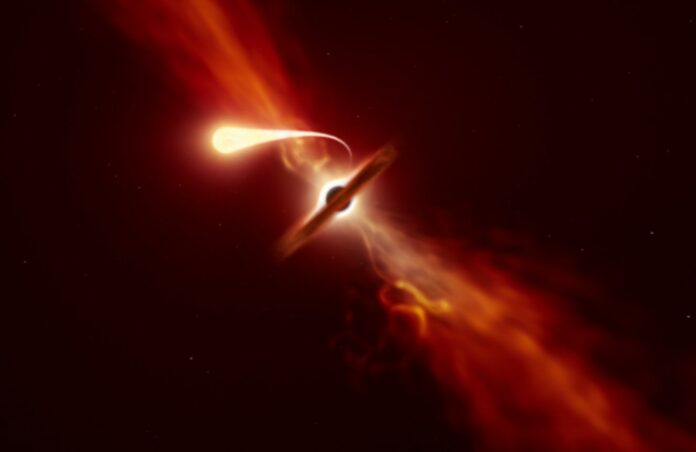Astronomers were keeping an eye on data from the Zwicky Transient Facility, an all-sky survey based at the Palomar Observatory in California when they noticed an unusual flash of light in a part of the sky where no such light had been seen the night before.
Roughly speaking, the amount of light produced by the flash would be equivalent to that of a thousand billion suns.
The team, lead by experts from NASA, Caltech, and other institutions, announced its finding in an astronomy newsletter, where it attracted the attention of astronomers from across the globe, including MIT scientists. Over the next few days, many telescopes zoomed in on the signal to get more information from X-ray, ultraviolet, optical, and radio wavelengths to figure out what could be making so much light.
The astronomers at MIT and their coworkers have now narrowed down the most probable origin of the signal. In a study published in Nature Astronomy, scientists say that the signal, called AT 2022cmc, probably comes from a relativistic jet of matter speeding away from a supermassive black hole at almost the speed of light. They have come to the conclusion that the jet is the result of a black hole that abruptly started consuming a nearby star and, in the process, released a significant amount of energy.
Astronomers have seen other “tidal disruption events,” or TDEs, where a passing star is torn apart by the gravitational pull of a black hole. AT 2022cmc shines brighter than any other TDE that has been found so far. The source is also the furthest TDE yet discovered, located more than halfway across the universe at a distance of 8.5 billion light-years.
How is it possible for something so far away to be so brilliant in our sky? The team thinks that the jet from the black hole may be pointing right at Earth, which would make the signal look brighter than if the jet were pointing in any other direction. The effect is called “Doppler boosting,” and it sounds like a passing siren turned up to 11.
This is the first Doppler-boosted TDE to be identified since 2011, making AT 2022cmc the fourth such event to be discovered. Additionally, it was the first TDE found using an optical sky scan.
More TDEs will be discovered when more potent telescopes come online in the next years, providing information on how supermassive black holes develop and affect the galaxies they orbit.
“We know there is one supermassive black hole per galaxy, and they formed very quickly in the universe’s first million years,” adds co-author Matteo Lucchini, a postdoc in MIT’s Kavli Institute for Astrophysics and Space Research. “That tells us they feed very fast, though we don’t know how that feeding process works. So, sources like a TDE can actually be a really good probe for how that process happens.”
First author Dheeraj “DJ” Pasham, Peter Kosec, Erin Kara, and Ronald Remillard are among Lucchini’s co-authors at MIT. There are also collaborators at universities and institutions around the world.
Following the original finding of AT 2022cmc, Pasham and Lucchini narrowed down on the signal using the Neutron star Interior Composition ExploreR (NICER), an X-ray telescope on the International Space Station.
During the first three days, Pasham says, “things looked pretty normal.”
“Then we looked at it with an X-ray telescope, and what we found was, the source was too bright.”
Such brilliant sky flashes are often gamma-ray bursts, which are very intense jets of X-ray emissions that result from the destruction of huge stars.
According to Pasham, this specific event was 100 times more potent than the strongest gamma-ray burst afterglow.
“It was something extraordinary.”
The team subsequently compiled data from other X-ray, radio, optical, and ultraviolet telescopes and monitored the signal’s behavior over the next weeks. The signal’s extraordinary brightness in the X-ray range was the most astonishing feature they saw. They discovered that during a few weeks, the X-ray emissions from AT 2022cmc fluctuated by a factor of 500.
They hypothesized that such intense X-ray activity must be caused by an “extreme accretion episode” – a tidal disruption event, for example, when a shredded star causes a whirlpool of material to collapse into a black hole.
In fact, the scientists discovered that AT 2022cmc’s X-ray brightness was equivalent to, but brighter than, three previously discovered TDEs. These brilliant phenomena produced matter jets that were directed directly towards Earth. If AT 2022cmc’s brightness is the consequence of a comparable Earth-targeting jet, how quickly must the jet be travelling to create such a brilliant signal, the researchers wondered? To find out, Lucchini made a model of the data from the signal, assuming that the event was caused by a jet flying straight toward Earth.
“We found that the jet speed is 99.99 percent the speed of light,” Lucchini adds.
The black hole must be in an exceptionally active phase, or what Pasham refers to as a “hyper-feeding frenzy,” in order to create such a powerful jet.
“It’s probably swallowing the star at the rate of half the mass of the sun per year,” Pasham adds. “A lot of this tidal disruption happens early on, and we were able to catch this event right at the beginning, within one week of the black hole starting to feed on the star.”
“We expect many more of these TDEs in the future,” Lucchini adds. “Then we might be able to say, finally, how exactly black holes launch these extremely powerful jets.”
Source: 10.1038/s41550-022-01820-x
